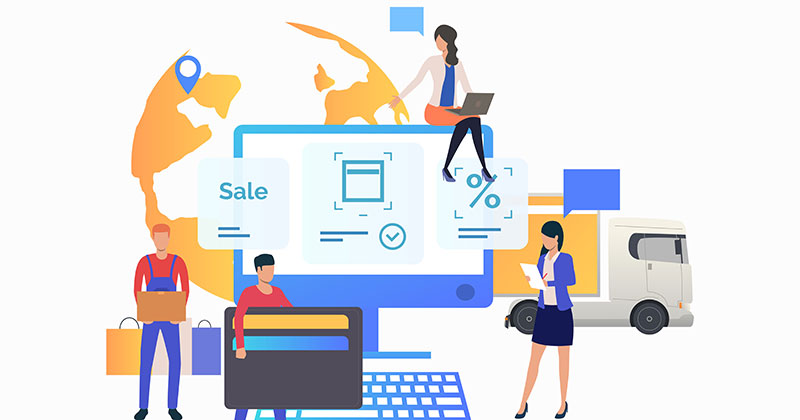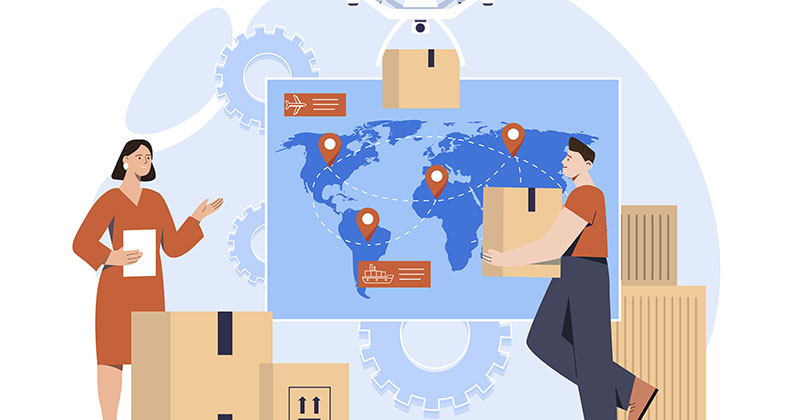How To Start A Dropshipping Business: A Beginner’s Guide.

Welcome to the World of Dropshipping
This beginner’s guide is designed to introduce you to the essentials of how to start a dropshipping business.
Dropshipping is a unique retail fulfillment method where a store doesn’t keep the products it sells in stock. Instead, when a store sells a product, it purchases the item from a third party and has it shipped directly to the customer. As a result, the seller doesn’t have to handle the product directly. This method stands out for its low entry barriers, reduced risk, and scalability, making it an attractive option for new entrepreneurs.
However, like any business model, dropshipping comes with its own set of challenges. It requires careful planning, market research, a knack for finding the right products and suppliers, and a solid strategy for attracting and retaining customers.
Our guide will walk you through each step of starting your own dropshipping business, from understanding the model, choosing your niche, setting up your online store, to marketing your products effectively. Whether you’re a complete beginner or someone looking to switch to an entrepreneurial lifestyle, this guide aims to provide you with a clear roadmap for success in the dropshipping world.
Let’s embark on this exciting journey together!

Understanding the Dropshipping Model
Demystifying How Dropshipping Works
At its core, dropshipping is a streamlined form of retail business where the seller accepts customer orders but does not keep goods sold in stock. Instead, the seller acts as a middleman between the supplier and the customer. Here’s a closer look at how this model operates:
- Customer Places an Order: When a customer makes a purchase from your online store, they pay the retail price you’ve set for the product.
- Order is Forwarded to the Supplier: You then forward the customer’s order to your dropshipping supplier, paying the supplier’s wholesale price. This difference between the retail and wholesale price is your profit.
- Supplier Ships the Product: The supplier takes care of the inventory and ships the product directly to your customer under your brand name.
This model stands in contrast to traditional retail where a store buys inventory in bulk, stores it, and then sells it to customers. The primary advantages of dropshipping include:
- Low Startup Costs: Unlike traditional retail, dropshipping doesn’t require a large upfront investment in inventory, making it accessible for many aspiring entrepreneurs.
- Flexibility: You can run your dropshipping business from anywhere with an internet connection. This flexibility allows you to start small and scale at your own pace.
- Wide Range of Products: Without the need to pre-purchase items, you have the freedom to offer a vast array of products to your customers.
- Reduced Risk: Since you’re not committing to buying inventory upfront, the risk of being stuck with unsold stock is significantly lowered.
However, dropshipping also presents challenges such as dependency on third-party suppliers, lower profit margins, and high competition. Success in this business model requires strategic planning, a focus on customer service, and an ongoing effort to stand out in the market.
In the following sections, we’ll delve into each of these aspects, helping you build a strong foundation for your dropshipping business.

Market Research and Niche Selection
Finding Your Place in the Market
One of the first and most critical steps in starting a dropshipping business is identifying a profitable niche. A niche is a specific market segment that caters to a particular audience or addresses a distinct need. Selecting the right niche can significantly influence the success of your dropshipping business. Here’s how to go about it:
- Conduct Market Research: Begin by exploring different markets and industries. Use tools like Google Trends, social media platforms, and market research reports to gauge consumer interests and emerging trends.
- Identify Profitable Niches: Look for niches that have a reasonable demand but aren’t oversaturated. Profitable niches often have a dedicated audience, clear pain points, and products that aren’t readily available in local stores.
- Evaluate Your Interests and Expertise: Aligning your niche with your personal interests or expertise can be beneficial. It keeps you motivated and gives you an edge in understanding the customer’s needs and preferences.
- Analyze the Competition: Check out potential competitors in your chosen niche. See what they’re doing right, what they’re missing, and how you can differentiate your business.
- Consider Long-Term Viability: While it’s tempting to jump on the latest trend, it’s crucial to think about the long-term potential of your niche. Evergreen niches or those with consistent demand are generally more sustainable.
- Validate Your Niche: Once you have a niche in mind, validate it by testing the market. This can be done through keyword research, creating a landing page to gauge interest, or running a small ad campaign.
Selecting the right niche requires a balance of market demand, competition, and personal interest. It sets the stage for your entire dropshipping business, influencing your marketing strategies, choice of products, and overall brand development.
In the next section, we’ll discuss how to find and partner with reliable suppliers, a key component of a successful dropshipping business.

Finding and Vetting Reliable Suppliers
Establishing a Strong Supplier Partnership
A crucial element of your dropshipping business is the supplier. They are responsible for maintaining product quality, managing inventory, and shipping orders to your customers. Therefore, choosing the right suppliers is paramount. Here’s how to find and vet reliable suppliers:
Research Potential Suppliers: Utilize platforms like AliExpress, Oberlo, SaleHoo, or ThomasNet to find suppliers that cater to your niche. Look for suppliers with high ratings, positive reviews, and a track record of reliable service.
- Evaluate Product Quality: Before deciding on a supplier, order samples of the products. This will help you assess the quality and delivery times, ensuring that your customers receive good products.
- Analyze Communication and Responsiveness: Effective communication with your supplier is vital. Evaluate their responsiveness to inquiries and their willingness to provide support. This is crucial for addressing any issues that may arise with orders.
- Negotiate Terms: Once you’ve selected a supplier, negotiate terms such as pricing, minimum order quantities, and shipping times. Establishing clear terms upfront can help avoid misunderstandings later on.
- Ensure Transparency and Trust: Transparency in business operations and mutual trust are essential for a long-term partnership. Make sure your supplier is clear about their capabilities and limitations.
- Consider Multiple Suppliers: Relying on a single supplier can be risky. Consider having multiple suppliers for the same product to ensure continuity in case of any supply chain disruptions.
- Check for Scalability: As your business grows, your supplier should be able to scale with you. Discuss their capacity to handle increased orders and maintain product quality.
Building a strong relationship with your supplier is critical. It not only ensures the smooth operation of your business but also impacts customer satisfaction. With the right supplier, you can focus on growing your business, knowing that the product quality and fulfillment are in good hands.
In the next section, we’ll cover the essentials of setting up your online store, a critical step in launching your dropshipping business.

Setting Up Your Online Store
Creating a Seamless E-Commerce Experience
Your online store is the heart of your dropshipping business. It’s where customers will browse and purchase your products, so creating a user-friendly and visually appealing store is crucial. Here’s a step-by-step guide to setting up your store:
- Choose an E-Commerce Platform: Select a platform that suits your business needs. Popular choices include Shopify, WooCommerce (for WordPress users), and Magento. Consider factors like ease of use, customization options, pricing, and available integrations.
- Design Your Store: Focus on creating a clean, easy-to-navigate website. Ensure your store’s design aligns with your brand and appeals to your target audience. Utilize high-quality images and a consistent color scheme.
- Optimize for Mobile Users: With a significant portion of online shopping occurring on mobile devices, ensure your website is mobile-friendly. This includes responsive design, fast loading times, and easy checkout processes.
- Set Up Payment Processing: Integrate reliable payment gateways like PayPal, Stripe, or Shopify Payments to offer multiple payment options. Ensure your checkout process is secure and user-friendly.
- Create Compelling Product Descriptions: Write detailed and enticing product descriptions. Include key features, benefits, and any other relevant information that would help in making a purchasing decision.
- Implement SEO Best Practices: Optimize your store for search engines to improve visibility. This includes using relevant keywords, optimizing product pages, and ensuring fast loading times.
- Plan for Customer Support: Set up a system for handling customer inquiries and support. This could be through email, live chat, or a helpdesk system.
Launching your online store is just the beginning. Regularly updating your site, optimizing for SEO, and enhancing the user experience are ongoing tasks that will help you attract and retain customers.
In the next section, we’ll dive into the world of digital marketing and explore strategies to promote your dropshipping store and attract customers.

Crafting Effective Digital Marketing Strategies
Driving Traffic and Sales Through Strategic Marketing
Having a great online store is just one part of the equation. Effectively marketing your dropshipping business is crucial for attracting and converting visitors into customers. Here’s how to develop a robust digital marketing strategy:
- Search Engine Optimization (SEO): Optimize your website and product pages for search engines to increase organic traffic. This includes using relevant keywords, creating quality content, and ensuring your site has a fast loading speed.
- Social Media Marketing: Use social media platforms like Facebook, Instagram, and Pinterest to reach your target audience. Post engaging content, interact with followers, and use targeted ads to promote your products.
- Email Marketing: Build an email list and engage with your customers through newsletters, product updates, and personalized offers. Email marketing helps in customer retention and encourages repeat purchases.
- Content Marketing: Create valuable content related to your niche, such as blog posts, videos, or infographics. This can help establish your brand as an authority in your niche and drive traffic to your site.
- Pay-Per-Click (PPC) Advertising: Invest in PPC campaigns on platforms like Google Ads or Facebook Ads to drive targeted traffic to your store. This can be an effective way to generate sales, especially in the early stages of your business.
- Influencer Partnerships: Collaborate with influencers in your niche to reach a broader audience. Influencers can help promote your products to their followers, increasing your brand’s visibility.
- Utilize Analytics: Regularly monitor the performance of your marketing efforts using tools like Google Analytics. This will help you understand what’s working and where you need to make adjustments.
Effective digital marketing requires a combination of strategies tailored to your target audience and niche. By consistently applying these tactics, you can increase your store’s visibility, attract more traffic, and boost sales.
In the following section, we will explore the intricacies of managing orders and ensuring top-notch customer service in your dropshipping business.
Managing Orders and Customer Service
Ensuring Smooth Operations and Customer Satisfaction
Efficiently managing orders and providing excellent customer service are pivotal to the success of your dropshipping business. These aspects greatly influence customer satisfaction and repeat business. Here’s how to manage them effectively:
- Streamlining the Order Fulfillment Process: Automate the process of forwarding customer orders to your supplier. Ensure there’s a system in place for tracking orders and keeping customers informed about the status of their shipments.
- Handling Shipping and Returns: Clearly communicate shipping policies, including expected delivery times and shipping costs. Have a straightforward and fair return policy to build trust with customers.
- Providing Exceptional Customer Service: Respond promptly to customer inquiries and complaints. Offer solutions and be willing to go the extra mile to resolve issues. Consider using live chat or helpdesk software for efficient communication.
- Managing Supplier Issues: In case of delays or problems from the supplier’s end, communicate openly with your customers. Offer explanations, apologies, or compensations if necessary, to maintain customer trust.
- Gathering Customer Feedback: Regularly seek feedback from your customers about their shopping experience. Use this feedback to improve your product offerings, website, and customer service.
- Leveraging Technology for Efficiency: Utilize tools and software for inventory management, order tracking, and customer relationship management to enhance operational efficiency.
- Developing a Loyal Customer Base: Encourage repeat business by offering excellent service, loyalty programs, or special discounts to returning customers.
By prioritizing order management and customer service, you not only enhance the shopping experience but also foster a loyal customer base. Happy customers are more likely to return and recommend your store to others.
In the next section, we’ll discuss how to analyze your dropshipping business’s performance and strategies for scaling up.

Analyzing Performance and Scaling Up
Growing Your Dropshipping Business Smartly
To grow and scale your dropshipping business, it’s essential to regularly analyze its performance and make data-driven decisions. Here’s how you can do this effectively:
- Monitor Sales Data: Keep track of which products are selling well and which aren’t. This information helps in making decisions about inventory, marketing focus, and potential new products.
- Use Website Analytics: Tools like Google Analytics provide insights into your website traffic, user behavior, and conversion rates. Understanding these metrics is key to optimizing your site and marketing strategies.
- Evaluate Marketing Campaigns: Regularly review the performance of your marketing campaigns. Look at metrics like click-through rates, conversion rates, and return on investment (ROI) to determine what’s working and what’s not.
- Customer Feedback and Reviews: Pay attention to customer feedback and reviews. They can offer valuable insights into product quality, customer service, and overall shopping experience.
- Identify Opportunities for Scaling: Based on your analysis, identify opportunities to scale your business. This could be through adding new products, expanding to new markets, or increasing your marketing efforts.
- Manage Cash Flow Wisely: As you scale, it’s crucial to manage your cash flow carefully. Reinvest profits into areas of your business that will drive growth, but also maintain a buffer for unforeseen expenses.
- Continuously Optimize Operations: As your business grows, continuously look for ways to optimize your operations. This could include automating more processes, improving customer service, or finding more efficient suppliers.
- Stay Adaptable: The e-commerce landscape is constantly changing. Stay adaptable and be ready to pivot your strategies as needed to respond to new trends and changes in the market.
Scaling a dropshipping business requires a combination of strategic planning, careful financial management, and ongoing optimization. By regularly analyzing your business and being adaptable to change, you can grow your dropshipping business successfully over time.
In the next section, we’ll cover the legal considerations and risk management strategies for your dropshipping business.

Navigating Legal Considerations and Risk Management
Staying Compliant and Minimizing Risks
Running a dropshipping business, like any other business, involves legal considerations and potential risks. It’s important to be aware of these and take steps to mitigate them. Here’s what you need to know:
- Understand E-Commerce Laws: Familiarize yourself with e-commerce laws and regulations in your country and any countries where you sell products. This includes consumer protection laws, privacy policies, and online business regulations.
- Register Your Business: Ensure that your dropshipping business is legally registered. This might involve obtaining a business license, registering for tax purposes, and setting up the appropriate business structure.
- Create Clear Terms and Conditions: Have clear terms and conditions for your online store, including return and refund policies, shipping policies, and privacy policies. This helps in protecting your business and informing your customers.
- Product Liability: Be aware of the liability associated with the products you sell. Ensure your suppliers comply with safety standards and quality controls to avoid selling faulty or unsafe products.
- Intellectual Property Compliance: Ensure that the products you sell do not infringe on intellectual property rights. Selling counterfeit or pirated goods can lead to serious legal consequences.
- Manage Supplier Risks: Establish strong agreements with your suppliers to manage risks such as supply chain disruptions. Having multiple suppliers for key products can mitigate this risk.
- Data Protection and Privacy: Ensure compliance with data protection laws like GDPR (if selling to European customers) by securing customer data and being transparent about how you use it.
- Stay Informed on Legal Changes: Laws and regulations can change. Stay informed about any changes that might affect your business and adjust your practices accordingly.
By understanding and addressing these legal and risk management considerations, you can build a more secure and trustworthy dropshipping business, thereby protecting yourself, your business, and your customers.
In the final section, we will conclude our guide and discuss the next steps for starting your dropshipping journey.
Conclusion and Next Steps
Embarking on Your Dropshipping Journey
Congratulations on taking the first steps toward building your own dropshipping business! By now, you should have a solid understanding of what dropshipping is, how to select a niche, find reliable suppliers, set up your online store, market your products, manage orders, and navigate the legal landscape.
Remember, like any entrepreneurial venture, dropshipping requires dedication, patience, and continuous learning.
Here are a few final tips as you embark on this journey:
- Start Small and Grow Gradually: Begin with a manageable range of products and scale up as you gain more experience and understanding of your market.
- Focus on Customer Experience: Providing an excellent customer experience can set you apart from your competitors. This includes everything from the quality of your products to your customer service.
- Keep Learning and Adapting: The e-commerce world is always evolving. Stay informed about the latest trends, tools, and strategies to keep your business competitive.
- Network and Seek Support: Join online communities, Shopify forums, and social media groups related to dropshipping. Networking with other entrepreneurs can provide valuable insights and support.
- Be Persistent: Success in dropshipping doesn’t happen overnight. Stay persistent, learn from your mistakes, and adapt your strategies as needed.
- Explore Further Resources: Continue your education by exploring more in-depth resources such as online courses, webinars, and books on dropshipping and e-commerce.
We hope this guide has provided you with the knowledge and confidence to start your dropshipping business. The journey ahead is exciting and full of opportunities. With hard work and determination, you can build a successful dropshipping business that stands the test of time.
Happy dropshipping!






